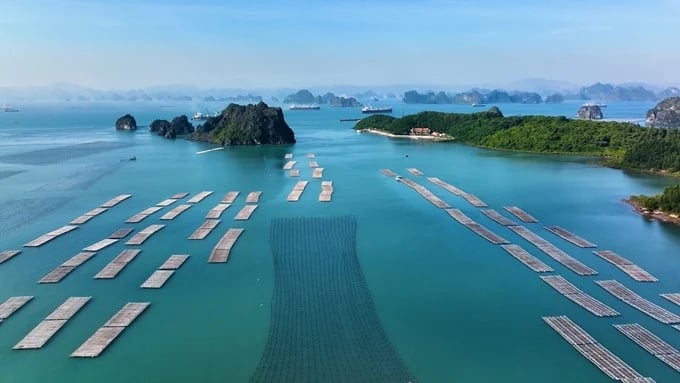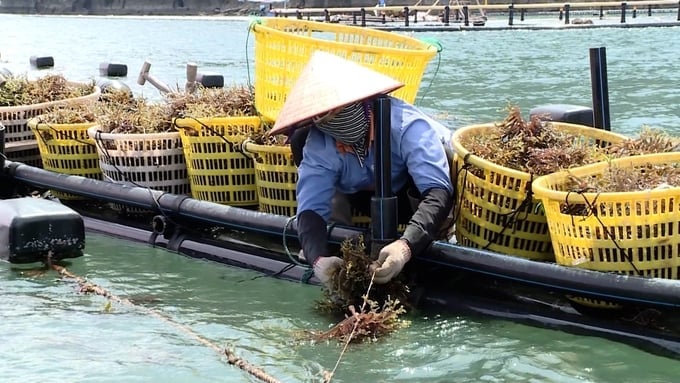November 27, 2025 | 00:21 GMT +7
November 27, 2025 | 00:21 GMT +7
Hotline: 0913.378.918
November 27, 2025 | 00:21 GMT +7
Hotline: 0913.378.918
Dr Pham Anh Tuan, former Deputy Director General of the Directorate of Fisheries, assessed the current development potential of seaweed and marine algae in Vietnam. This is also one of the solutions that Dr. Pham Anh Tuan shared with the desire to propel Vietnamese aquaculture "beyond the waves and winds," accelerating breakthroughs in the near future.
According to Dr Pham Anh Tuan, there are several urgent solutions that need to be addressed to promote the development of aquaculture. Firstly, investments in science and technology are needed to solve the issue of breeding for certain species with good market demand and potential for aquaculture development.

For offshore aquaculture, favourable policies are needed to encourage and attract investors. Photo: Duy Hoc.
Secondly, some aquaculture species still rely on miscellaneous fish as feed, so there is a need to focus on researching and producing feed that reduces dependence on fishmeal and utilizes miscellaneous fish species.
Thirdly, in marine aquaculture, there are two farming zones: nearshore and offshore. For nearshore farming zones, the basic types and significant environmental burdens have been identified. Therefore, production needs to be reorganized and planned to ensure that the scale and management methods in these areas are suitable for environmental capacity. Only then can diseases be reduced, sustainability achieved, and environmental and ecological protection requirements from markets met.
As for offshore aquaculture, favourable policies are needed to encourage and attract investors, along with the development of appropriate science and technology, especially human resource training.
Dr Pham Anh Tuan emphasized, "Another thing to consider is the potential of seaweed and marine algae, which are currently almost neglected and receive less attention compared to other species such as fish or crustaceans. Seaweed and marine algae have environmental protection advantages and contribute to sustainable economic development, not only meeting food demand but also being usable in other fields such as pharmaceuticals, cosmetics, animal feed, and fertilizers..."
"If all of these issues are addressed, I believe that Vietnamese aquaculture can develop sustainably", said Dr. Pham Anh Tuan.
Associate Professor Dr Nguyen Chu Hoi, a Member of the National Assembly of the 15th term and vice Chairman of the Vietnam Fisheries Association, also emphasized the need to diversify aquaculture species. Besides traditional species like shrimp and fish, efforts should be made to promote new species such as seaweed and marine algae, especially those with potential as medicinal materials to develop a new marine economy - the marine medicinal material industry. Maintaining seaweed beds, seagrasses, mangroves, and coral reefs is important to ensure their carbon sequestration function, contributing to climate change adaptation.
"We have a common medicinal plant sector, but not marine medicinal materials. Vietnam is a country with a large marine area, and the potential for marine medicinal materials is significant. In a tropical climate, it is favourable for the development of these species to produce nutritious food, reduce raw material exports, promote processing, and create added value. Doing so is also a way to conserve natural resources", emphasized Mr Nguyen Chu Hoi.
Currently, there are about 200 seaweed species with commercial value worldwide, of which 27 are primarily cultivated. The total seaweed production is over 36 million tons (35 million tons of cultivated seaweed), with an estimated value of over $ 8.3 billion.
According to statistics from the Directorate of Fisheries, Vietnam currently has over 827 natural seaweed species, of which 88 have economic value, classified into three main groups: cartilaginous seaweed, filamentous seaweed, and grape seaweed.
The potential area for seaweed cultivation in Vietnam is about 900,000 ha. In 2023, the total area of seaweed cultivation was about 16,500 ha, with a production of 150,000 tons. Profit from grape seaweed cultivation reached about VND 150 - 200 million/ha; for cartilaginous seaweed cultivation, the profit was about VND 60 - 80 million/ha. Seaweed and algae aquaculture is currently helping to provide livelihoods for coastal communities.

In 2023, the total area of seaweed cultivation was about 16,500 hectares, yielding 150,000 tons. Photo: Duy Hoc.
In 2023, the total area of seaweed cultivation was about 16,500 ha, yielding 150,000 tons. The seaweed industry in our country currently has many opportunities for development, such as the global market growing at over 10%/year. Moreover, seaweed has the ability to absorb CO2 five times faster than land plants, providing an opportunity to sell carbon credits. The trend of using green food and energy is also increasingly popular. The compounds found in seaweed can be utilized in various fields such as pharmaceuticals, cosmetics, animal feed, and organic fertilizers.
As part of the strategy for developing the fisheries sector, Vietnam aims to strive for seaweed and algae production of around 180,000 tons by 2025 and 500,000 tons by 2030. This includes focusing on nearshore development from Thanh Hoa to Quang Binh for the cultivation of specific seaweed varieties like kelp, cartilage seaweed, and golden filamentous algae. In offshore areas, there are more diverse development methods, where seaweed can be cultivated alone or in combination with shrimp, fish, or high-value algae products.
Translated by Hoang Duy

(VAN) Tay Ninh’s livestock sector is undergoing a major transformation, applying high-tech, closed-loop circular models to build sustainable value chains.
/2025/11/26/3627-4-082628_818.jpg)
(VAN) From a small café on the red basalt highlands, Le Van Hoang started a business with clean coffee, building Enjoi Coffee into a symbol of organic agriculture in the Lam Dong plateau.
/2025/11/25/0045-1-135246_13.jpg)
(VAN) Ca Mau is researching a model of sea-encroaching embankments combined with viaducts and logistics service zones, aiming both to prevent erosion and create land funds for marine economic development.

(VAN) The information was shared at the seminar 'Urban Agriculture - Solutions for Developing Green Spaces,' organized by the Kinh te & Do thi Newspaper and the Biotechnology Center of Ho Chi Minh City.
/2025/11/19/4141-2-132831_216.jpg)
(VAN) One of Japfa's outstanding solutions is implementing digital transformation and artificial intelligence (AI) to optimize operations, enhance productivity, and advance sustainable development.
/2025/11/19/4847-1-093540_448.jpg)
(VAN) The Gia Lai Provincial People’s Committee had a working session with the delegation of the U.S. Department of Agriculture, the State of Idaho, and representatives of the State's leading enterprises.

(VAN) Ca Mau has a sufficient foundation to become a strong regional aquaculture center, where production integrates the economy, the environment, and the lives of the people.